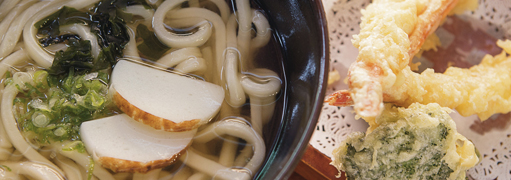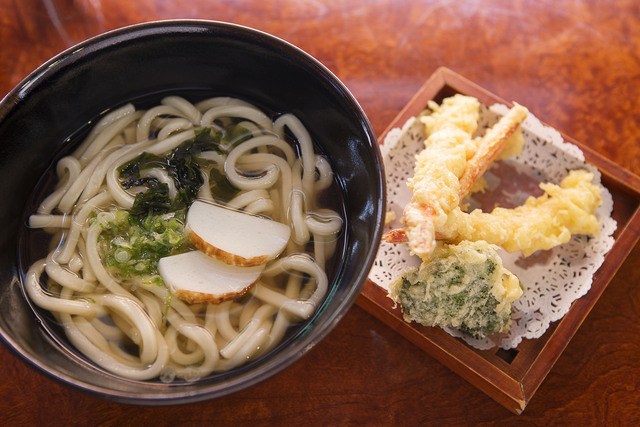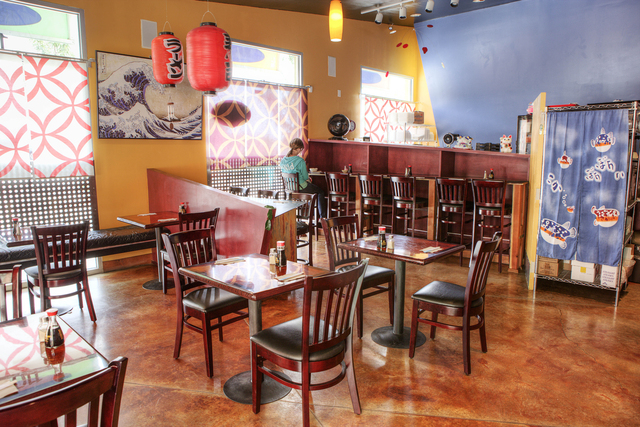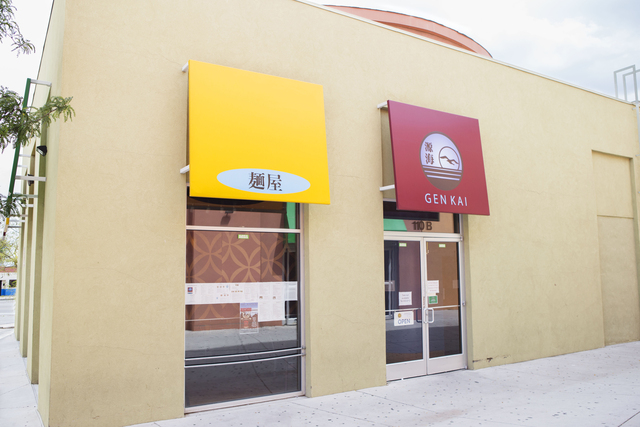In a small building that juts into the parking lot of Talin Market, where a bubble tea house used to serve mediocre sushi, the Japanese restaurant Gen Kai recently set up shop. Given that it’s bordered by a hot blacktop on one side and the rush of Louisiana on the other, you might worry about a hot and chaotic dining experience. But it’s another world inside, an air-conditioned oasis shielded by artistic window coverings that block out the steaming bustle.Gen Kai is the reincarnation of Light & Healthy Mirai Express, a University-area restaurant that holds a special place in my heart for being the first place I ever ate in Albuquerque. Former Mirai patrons will recognize Lily Genka, the former owner of Mirai who ran it practically as a one-woman show. At the new location Genka appears to have more help.I was in the process of preparing a review of Mirai last year just before it closed. I liked Mirai, but I prefer Gen Kai. While many of Mirai’s dishes went over to Gen Kai unchanged, the sushi is noticeably better, among other improvements.The sushi menu is short, the fish is fresh, and the rolls trend toward the simple, which is just fine by me. I don’t need bells and whistles in my sushi; I need the basics done properly, and the sushi at Gen Kai delivers. Especially the hamachi, typically the most buttery, flavorful, melt-in-your-mouth fish on any sushi menu. At Gen Kai the hamachi is fresh and cut into large chunks. From succulent slabs on your nigiri, robust rectangular logs in your hamachi scallion roll, or as sashimi medallions, you get enough of that delicious hamachi to sink your teeth into.While hamachi is the most satisfying item on the sushi menu, the natto roll is the most interesting. Natto, made from whole soy beans fermented with the microorganism Bacillus subtilis, is gooey, slimy, and shall we say, an acquired taste. The texture is more noticeable than the flavor, which is more salty and subtle than weird. In a hand roll with shizo leaf, the natto flavor was remarkable and made the texture more than tolerable. A dragon roll of eel and avocado on a California roll with teriyaki sauce was also good, as was the cucumber avocado roll.There is a strong contingent of soups on the menu as well. The line-up of ramen soups, which come in your choice of four broths (miso, soy, salt and tonkatsu) and choice of thick or thin noodles, rivals any in town. I prefer the tonkatsu broth at Gen Kai to that of O Ramen, as it’s richer and less busy. Even though it arrived with a rather small piece of pork, the Gen Kai tonkatsu is still my favorite in town—but for those who care more about pork than broth, the best showing of pure pork flesh in a bowl of Duke City ramen, hands down, can be found at Wasabi on Tramway and I-40.I tried the shio ramen as well, which quenched a long-held curiosity as to how salt broth ramen tastes. Verdict: not as good as tonkatsu. But then, what is? All of the ramen can be made spicier by the addition of chile oil and a chile or garlic “bomb,” a mayo-like soup-flavoring condiment.The udon soups, while simpler than the ramen, might be more satisfying. The thick noodles are supple and chewy, and the broth is rich, dark and deep. Many of the soups at Gen Kai are minimally altered transplants from Mirai, including one of my favorites, the sansai soba, cold soba noodle soup. Sansai means hand-gathered, wild mountain vegetables, although today some of the plant species that qualify are cultivated. There is a sansai udon soup too, which comes hot and makes you sweat. Both cold soba and hot udon are simple bowls of soup, not what you want if you’re in search of fireworks. Both sansai soups are hydrating, obviously, and both are refreshing, even the hot udon which invokes sweat that refreshes. You’ll need that cooling moisture in order to brave the hot parking lot that surrounds the little restaurant.Yet another strength of Gen Kai are the donburi bowls, don for short, which are bowlfuls of rice with various flavors of stuff on top. My favorite was the oyako don, in which dashi-soaked rice is topped with a fried combination of chicken and egg, with two forms of onion: bulb and green. I’ve long been intrigued with this combination and tried it elsewhere, but this was the first time I felt like it lived up to my expectations of how good it could be.The pork donburi, which also features egg and both kinds of onion, along with breaded pork pieces, was good as well, a respectable second to the oyako don. I’d steer the would-be donburi eater toward one of these masterpieces rather than the spicy tuna and salmon sushi donburi bowls, which lack the same gestalt. Perplexingly, the wonderful unagi (eel) don didn’t make the trip from Mirai. Another favorite left behind was the tempura-fried ice cream.There are bento boxes as well, including the teriyaki mackerel, which would have been great if it wasn’t so salty. The curry is fragrant and complex. I tried it on the boiled pork, which was chewy and otherwise nondescript, and with soba noodles and broccoli—pretty good for a vegan dish.Off the appetizer menu, the agedashi tofu was lightly fried on once side, naked on the other, daintily garnished with seaweed and scallions and served with a tempura dipping sauce. It was a delicious, understated version of this classic. The chicken karaage tasted faintly of ginger and had a crusty fried coating. Not my favorite, but the chicken inside was chewy enough to make it interesting, and perhaps authentic. I washed down my food with an unsweetened green tea that was sublime, while my son drank a sweet and creamy iced tea—it was Thai iced tea as far as I could tell—that was decadent and rich.As I paid my bill, I asked Lily Genka how business was going in the new place. “It’s good,” she told me. “It really helps to have all of this parking.”
Gen Kai110 B Louisiana NE255-0112Hours: 11am-8pm dailyVegetarian, vegan and gluten-free friendlyAmbiance: Not your normal parking lot eateryPrice range: $3-$10The Weely Alibi recommends: Anything hamachi, oyako don, tonkatsu ramen, cold sansai soba












